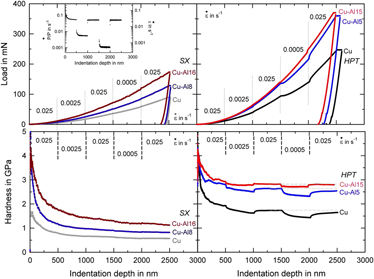Article contents
Influence of solid solution strengthening on the local mechanical properties of single crystal and ultrafine-grained binary Cu–AlX solid solutions
Published online by Cambridge University Press: 22 August 2017
Abstract

In this work, the influence of Al-solutes on the mechanical behavior of Cu–AlX solid solutions has been studied using indentation strain rate jump tests for single crystalline and ultrafine-grained (UFG) microstructures from high pressure torsion (HPT) processing. Al-solutes in Cu classically lead to a solid solution strengthening, coupled with a decrease in stacking fault energy, which influences also the grain size after HPT processing. For all alloys, a higher hardness is found at lower indentation depths, which can be nicely described by a modified Nix/Gao model down to 100 nm indentation depth. Among the single crystals, the largest size effects are found for the higher solute contents, indicating a stronger work hardening at small length scales for the solid solutions. The dilute UFG solid solutions showed a strong softening after a strain rate reduction test, with a pronounced transient region. Cu–Al15 is, however, quite stable, showing abrupt changes in hardness without strong transients. This indicates that solute solution strengthening does not only influence the indentation size effect and structure formation during HPT processing but also stabilizes the grain structure during subsequent deformation.
- Type
- Articles
- Information
- Journal of Materials Research , Volume 32 , Issue 24: Focus Issue: Mechanical Properties and Microstructure of Advanced Metallic Alloys—in Honor of Prof. Haël Mughrabi PART B , 28 December 2017 , pp. 4583 - 4591
- Copyright
- Copyright © Materials Research Society 2017
Footnotes
Contributing Editor: Mathias Göken
References
REFERENCES
- 12
- Cited by



